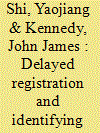|
|
|
Sort Order |
|
|
|
Items / Page
|
|
|
|
|
|
|
| Srl | Item |
| 1 |
ID:
149748


|
|
|
|
|
| Summary/Abstract |
In 2010, according to the sixth Chinese census, the sex ratio at birth (SRB) was 118 males for every 100 females. The global SRB average is about 105. Thus, the gap between 118 and 105 is made up of “missing girls.” Scholars present three main explanations for the skewed SRB statistic: sex-selective abortion, infanticide and delayed or late registration. Most studies take a demographic and cultural approach to explain the high SRB. However, we believe the story of the “missing girls” is also an administrative one and adopt the street-level bureaucrat theory of policy implementation to explain the pervasiveness of late registration in rural China. We use descriptive statistics derived from the 1990, 2000 and 2010 census data to identify the “missing girls.” We believe the combination of late registration and unreported births may point to a larger proportion of “missing girls” than previously reported from the SRB statistic.
|
|
|
|
|
|
|
|
|
|
|
|
|
|
|
|
| 2 |
ID:
155673


|
|
|
|
|
| Summary/Abstract |
In a recent article published in this journal, Yaojiang Shi and John Kennedy suggest that China's missing girls problem is much more a statistical artefact than previously known. According to their analysis, unreported female births, or hidden girls, account for 73 per cent of the 15 million missing girls from the 1990–2010 birth cohorts in the 2010 census. Their conclusion is based in part on their fieldwork, but the numerical estimate is grounded on their understanding and analyses of Chinese census data. While the insights from their fieldwork – that China's political system leaves ample room for data manipulation and delayed registration – cannot be faulted, Shi and Kennedy's analyses of Chinese census data are questionable and their conclusion is in contradiction with the “missing girls” shown in other data sources. In this short note, I present three lines of evidence to challenge Shi and Kennedy's conclusion: one from the censuses, one from official education statistics, and one from survey data. For the sake of clarity, I use two terms to describe missing girls: nominal missing – the number of missing girls as revealed by population statistics, and truly missing – the number of missing girls excluding those hidden (unreported) girls. My conclusion backs the conventional wisdom about the missing girls phenomenon in China: the elevated sex ratios in Chinese population, or “missing girls,” is not a statistical artefact, but a real social challenge that China has to face for now and for the foreseeable future.
|
|
|
|
|
|
|
|
|
|
|
|
|
|
|
|
| 3 |
ID:
155674


|
|
|
|
|
| Summary/Abstract |
We thank Yong Cai for his comments and insights regarding our piece on the “missing girls.” We also recognize and appreciate his expertise in the field of population studies. In short, we agree that we have overestimated the number of nominally missing girls and that the number of hidden or recovered girls may be closer to 10 million or half of the truly missing girls rather than 15 million. Of course, the number of truly missing girls is inconclusive due to the lack of direct measures and the reliance on proxy measures such as previous census data, surveys and state education data. Given the absence of direct measures for the truly missing, scholars also rely on assumptions of villager behaviour and local policy implementation, such as the continued prevalence of son preference as well as the implementation of birth control measures across rural China. Our aim for the “missing girls” article is not to solely challenge the numbers (because we realize the margin of error is in the millions), but we want to challenge the social and political assumptions behind the truly missing. Therefore, we believe the debate over the general estimates of the truly missing is real and should continue.
|
|
|
|
|
|
|
|
|
|
|
|
|
|
|
|
|
|
|
|
|